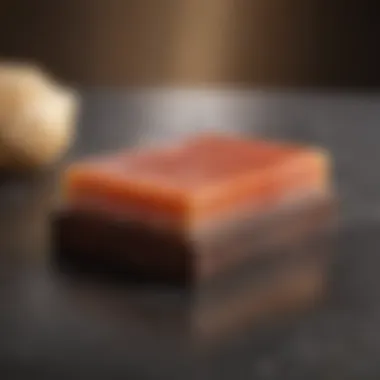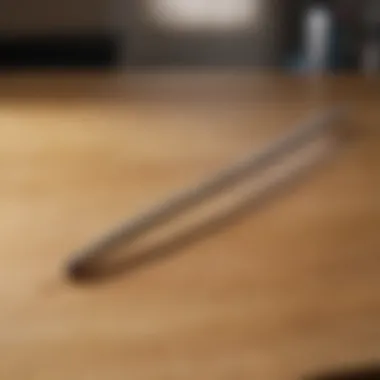Ultimate Knife Sharpening Tools Guide for Chefs


Intro
Knife sharpening is an essential skill for anyone who spends time in the kitchen. Not only does a sharp knife make the task of preparing food easier, but it also enhances safety by reducing the need for excessive force. In this guide, we will explore the tools available for sharpening knives. We will examine their effectiveness, advantages, and limitations. This knowledge is crucial for culinary enthusiasts seeking to maintain their knife collection effectively.
Using the right tools can significantly impact the quality of your knife's edge. Different methods serve unique needs; whether you are a novice cook or seasoned chef, knowing which tool to use can dramatically improve your cooking experience. A well-maintained knife not only performs better but also lasts longer. This guide aims to provide practical advice on optimal knife maintenance, ensuring you can cut with precision, safety, and ease.
"A sharp knife is not just a tool; it is an extension of the chef's will."
As we delve deeper into this topic, we will categorize the sharpening tools into distinct types, including whetstones, electric sharpeners, and honing rods. Each section will highlight key characteristics, use cases, and best practices, which will help you choose the best sharpening tool for your specific needs.
Understanding Knife Sharpening
Knife sharpening is a crucial skill for anyone who values precision in the kitchen. A well-maintained knife not only enhances cooking efficiency, but also ensures safety during food preparation. Understanding the nuances of knife sharpening empowers culinary enthusiasts to maintain their tools in optimal condition, which is vital for both amateur cooks and professional chefs. Sharp knives reduce effort during cutting, thereby minimizing the risk of accidents that can occur due to slips with poorly maintained blades.
Importance of a Sharp Knife
A sharp knife can significantly enhance the cooking experience. One of the key advantages is that it allows for cleaner cuts, preserving the integrity of the ingredients. For instance, when slicing through delicate herbs or ripe tomatoes, a sharp blade ensures that the cuts are smooth rather than tearing the flesh. This not only improves the presentation of dishes but also can enhance the flavors extracted from the ingredients, as the cell walls remain intact.
In addition, a sharp knife requires less force to cut through food. This reaction can reduce fatigue during extended cooking sessions. Less pressure also means better control, which ultimately translates to a safer cooking environment. Conversely, using a dull knife increases the likelihood of slipping and miscuts, heightening the risk of kitchen accidents.
Basic Principles of Knife Sharpening
Knife sharpening involves aligning the edge of a blade to create a point that can efficiently slice through food. There are several principles to keep in mind when sharpening knives. First, understanding the angle at which to hold the blade against the sharpening tool is important. Most kitchen knives require an angle between 15 degrees to 20 degrees to achieve the best results.
Next, the method chosen for sharpening will affect the results. Techniques vary from using whetstones to electric sharpeners, each with distinct processes and outcomes. While whetstones require skill and practice, they provide a more controlled sharpening experience. Electric sharpeners, on the other hand, offer quick results but may over-sharpen if not used correctly.
Finally, consistency plays a significant role in knife sharpening. Maintaining a steady hand and consistent angle throughout the process will yield a sharper, more effective blade. Regular honing, which is different from sharpening, aids in maintaining the edge of the knife, prolonging the intervals needed for complete sharpening.
"A sharp knife is not just a tool; it is an extension of the chef’s skill and creativity in the kitchen."
Understanding these basic principles can transform the approach one takes towards knife maintenance. Knowing how to effectively care for knives can eventually lead to a more enjoyable and efficient cooking process.
Types of Knife Sharpening Tools
Understanding the various types of knife sharpening tools is crucial for anyone looking to maintain their knives effectively. Each tool has its own set of features, advantages, and disadvantages. The right tool can make a significant difference in the sharpening process. Therefore, it is essential to familiarize oneself with these tools to make an informed decision that meets your requirements.
Whetstones
Different Grit Levels
Different grit levels in whetstones determine the level of abrasiveness. Coarse grit, usually 200 to 600, is suitable for reshaping edges. Medium grit, around 800 to 1500, is perfect for sharpening. Fine grit, above 3000, polishes the edge to create a sharp finish. This variation is beneficial because it allows the user to select a stone based on the knife's condition. A whetstone's ability to cater to specific needs makes it popular among knife enthusiasts. The advantage lies in versatility, but using the wrong grit can lead to ineffective sharpening.
Using a Whetstone Effectively
Using a whetstone effectively involves maintaining the right angle and applying consistent pressure. A common angle for most knives is about 20 degrees. The unique feature of a whetstone is that it sharpens gradually, leading to better precision. Its popularity stems from this careful approach to sharpening. However, it demands skill and practice, which can intimidate beginners. Proper technique also ensures longevity not only for knives but also for the whetstone itself.
Electric Sharpeners
Pros and Cons
Electric sharpeners offer a quick and easy way to sharpen knives. The main advantage is speed; they can sharpen a knife in seconds. They often have preset angles, which removes the guesswork associated with manual sharpening. However, a potential disadvantage is that they may remove too much material from the blade. This can shorten the knife's lifespan. For convenience, an electric sharpener might be the right choice, but caution is necessary to avoid excessive wear.
Recommended Models
Popular models of electric sharpeners like Chef'sChoice 15 Trizor XV and Work Sharp Knife & Tool Sharpener are known for their effectiveness. They provide multiple sharpening stages, which can be very useful. Such models come with built-in safety features and user-friendly designs. Choosing a specific model hinges on the knife types in one's collection. While electric sharpeners can simplify the process, they might not be suited for all types of knives, particularly high-end or specialty ones.


Honing Rods
Functionality
Honing rods are often mistaken for sharpening tools, but they serve a different purpose. Their main function is to realign the blade's edge rather than remove metal. This quick fix can maintain sharpness between sharpening sessions. The key characteristics of honing rods include ease of use and portability. They can be used frequently without damaging the blade. However, reliance solely on honing may lead to dull knives over time.
Maintenance and Use
Maintaining a honing rod requires little effort; regular cleaning after use is usually sufficient. For effective use, hold the rod vertically and run the blade down it at a 15 to 20-degree angle. The unique feature of honing rods is their ability to extend the life of sharper blades without the need for extensive sharpening. It is beneficial for anyone who uses their knives regularly. The limitation is that they do not replace the necessity of actual sharpening.
Pull-through Sharpeners
Ease of Use
Pull-through sharpeners are designed for simplicity. They require minimal skill, making them an appealing choice for many home cooks. Users simply draw the knife through the tool, and the sharpening action occurs automatically. This ease of use is a primary reason for their popularity among casual chefs. However, it often sacrifices precision for convenience.
Limitations
One significant limitation of pull-through sharpeners is that they may not sharpen all knife types evenly. Some may produce inconsistent results, especially on high-quality knives. They also tend to wear down the blade more quickly. For those who use knives sparingly, they can be a decent alternative, but dedicated cooks might find them inadequate over time.
Handheld Sharpeners
Types and Variations
Handheld sharpeners come in various types, including manual and powered versions. They are compact and user-friendly, allowing for quick touch-ups on the go. Their versatility makes them a beneficial choice for many. However, not all handheld sharpeners are effective for every knife type. Varied design influences their efficiency.
Best Practices
Best practices for using handheld sharpeners involve familiarizing oneself with the design before use. Following the manufacturer’s instructions ensures the best results. This simple, hand-held option can be effective if used correctly and frequently. However, improper use can lead to uneven sharpening and even damage to the blade.
Proper technique and understanding of how each sharpening tool works is fundamental to maintaining knives effectively.
Factors to Consider When Choosing a Sharpening Tool
Selecting the right sharpening tool is crucial for maintaining the performance of your knives. The choice of tool impacts the effectiveness of sharpening, its ease of use, and ultimately, the longevity of your knives. Different knives have varying needs based on material, usage, and users. In this section, we dive into some essential factors that affect the decision-making process.
Knife Material
Stainless Steel vs. Carbon Steel
When it comes to knife materials, stainless steel and carbon steel are two common options. Each material has distinct properties that inform how they should be sharpened.
Stainless steel is easier to maintain because it resists rust and corrosion. This feature makes it a popular choice for home cooks and professionals alike. However, it can be more challenging to sharpen. The hardness of stainless steel means it might require specific sharpening techniques or tools.
On the other hand, carbon steel is known for its ability to maintain a sharper edge longer than stainless steel. It sharpens more easily but is prone to rust without proper care. Cooks who favor sharpness often prefer carbon steel for its cutting performance. But it's crucial to note that proper maintenance is needed to avoid degradation.
Choosing the correct sharpenr tool is significantly determined by knife material, as each type requires diverse approaches.
Impact on Sharpening Method
The material influences the sharpening method applicable to your knife. For instance, stainless steel may benefit from whetstones with finer grits due to their hardness, while carbon steel might reach its optimal sharpness with coarser wheels or stones.
This correlation highlights the importance of understanding your knife's material for effective sharpening. By selecting the right method, users can achieve sharper, longer-lasting edges. Knowing how different materials react during the sharpening process also aids in avoiding damage to your knives.
Frequency of Use
Professional vs. Home Use


The frequency of knife use dictates the sharpening tool choice significantly. Professional chefs typically sharpen their knives more often than home cooks do. This difference necessitates specific tools that can handle repeated sharpening without degrading over time. For instance, professionals may opt for whetstones or electric sharpeners that allow quick and efficient honing.
Home cooks, on the other hand, might find handheld sharpeners sufficient since their knives do not require constant maintenance. Understanding your needs can help in determining the most practical sharpening tools.
Choosing Appropriate Tools
Choosing the right sharpening tool varies with the nature of knife usage. Professional environments might favor high-quality whetstones, while casual cooks may find manual pull-through sharpeners quick and efficient. Factors like time investment, skill level, and desired sharpness degree result in different tool requirements.
For someone who uses their knives often, investing in premium electric sharpeners or high-grit whetstones proves beneficial in the long run. Meanwhile, infrequent users can usually maintain knife sharpness with more accessible tools.
Skill Level
Beginner Considerations
For novice cooks, beginner-friendly tools are essential. Simplicity is key. A good entry-level sharpener should clearly guide users, ensuring safety and reducing the chance of knife damage. Products like pull-through sharpeners or simple handheld options are ideal.
These tools often come with visual aids or marked grooves, simplifying the sharpening process for first-timers. However, users should learn the basics of maintaining knife sharpness, as this knowledge is crucial for moving beyond basic tools.
Advanced Options
As skills develop, so should the sharpening tools. Those with more experience may appreciate whetstones or electric sharpeners that offer greater precision and control. These advanced tools, while requiring more technique and care, lead to superior results.
Learning to use advanced tools enables a deeper understanding of knife care and maintenance. Ultimately, these options encourage users to take full advantage of their knife's capabilities, providing a better cooking experience.
Step-by-Step Guide to Sharpening Knives
Sharpening knives is not merely a mechanical task; it is an essential skill for anyone who values their culinary experiences. The significance of a well-sharpened knife cannot be overstated. A sharp knife ensures smooth cutting, promotes safety by reducing the chance of slipping, and enhances the overall cooking experience. It allows for precision, whether one is slicing meats, chopping vegetables, or presenting dishes. Understanding how to sharpen knives properly can yield improved performance and longevity. This section will break down the critical steps in the sharpening process, focusing on preparation, technique, and testing for optimal results.
Preparing the Knife and Tool
Cleaning the Knife
Cleaning the knife is a fundamental yet often overlooked step before sharpening. This process involves removing any remnants of food, oil, or dirt that could affect the sharpening outcome. A clean surface ensures that the sharpening tool can effectively engage with the blade steel, allowing for an accurate edge restoration. The primary characteristic of cleaning the knife includes using warm, soapy water and a soft cloth or sponge to avoid scratching the surface. Not only is this method beneficial in preventing cross-contamination, but it also extends the lifespan of the knife by preventing residue buildup. However, one disadvantage may arise when improper cleaning techniques lead to potential damage. Thus, attention must be given to the cleaning process to maintain knife integrity.
Setting up the Sharpening Area
The setup of the sharpening area is crucial for effective knife sharpening. Having a designated, clutter-free space aids concentration and minimizes the risk of accidents. A stable surface, preferably a sturdy table or counter, is ideal. Key characteristics of the sharpening area include adequate lighting to observe the blade angle, as well as sufficient space to maneuver comfortably. This organization is beneficial for maintaining focus and preserving the cutting edge's alignment during the process. A unique feature of a well-prepared area is the inclusion of a damp cloth underneath the sharpening tool to prevent slipping. While this setup makes the sharpening process more efficient, it requires regular organization and cleanliness to keep it effective and safe.
Sharpening Techniques
Whetstone Technique
The whetstone technique is a classic method employed to sharpen knives effectively. This technique allows for control over the knife edge and is favored for its ability to create a razor-sharp blade. Users appreciate the precision afforded by the whetstone, as it requires a slight angle adjustment to achieve the desired sharpness. A unique feature of this method is the choice of grit levels, where coarser stones remove material quickly, while finer stones polish and refine the edge. The primary advantage is the high level of customization available for different knife types and preferences. Nonetheless, it requires practice to master, which can be a downside for beginners looking for immediate results.
Using Electric Sharpeners
Electric sharpeners offer a quick and convenient way to sharpen knives, making them appealing to those who may lack experience or time. They operate with powered mechanisms that automate the sharpening process, providing consistent results without much effort. The primary characteristic is their user-friendliness, where one simply needs to insert the knife and let the machine do the work. This saves time and reduces the chance of user error, making it a popular choice. However, electric sharpeners can sometimes remove more material than necessary, leading to a gradual decrease in knife lifespan. Understanding how often to use them is essential to avoid unnecessary wear on your blades.
Testing the Sharpness
Visual and Practical Tests
Testing sharpness is an essential part of the sharpening process. Visual and practical tests determine if the knife is sharp enough for use. A simple visual inspection involves looking for a clean, even edge. Additionally, practical tests like the paper test can provide immediate feedback on sharpness—slice a sheet of paper to check for smooth cutting. This dual approach ensures reliability in determining the knife’s performance. The significant advantage of these tests lies in their simplicity, requiring no special tools or experience. However, visual inspections might lead to overconfidence, so tactile tests are recommended to always verify performance effectively.
Safety Considerations


Safety considerations are a paramount aspect of knife sharpening. Without proper precautions, the process can lead to accidents and injuries. Key characteristics of safety practices include using a stable surface, maintaining a proper grip, and employing personal protective equipment such as cut-resistant gloves. These measures are vital, especially for novices who may not be familiar with handling sharp instruments. A unique feature of proper safety protocols is maintaining awareness of one’s body positioning relative to the blade. While understanding these practices takes time and effort, they are invaluable in reducing the risk of injury and ensuring a safe sharpening experience. Neglecting safety can lead to severe consequences, which can overshadow the benefits of sharp knives.
Maintaining Sharp Knives
Maintaining sharp knives is a crucial aspect of knife ownership. A sharp knife not only enhances cutting efficiency but also ensures safety. A dull knife requires more force, increasing the risk of slips and accidents. Regular maintenance practices, therefore, are integral in preserving the longevity and functionality of your knives.
This section will outline essential practices for keeping knives sharp and safe. We will cover daily honing techniques as well as proper storage methods. Understanding these elements will allow culinary enthusiasts to maximize the performance of their knife collection.
Regular Maintenance Practices
Regular maintenance involves a few easy habits that can dramatically affect a knife's lifespan and cutting performance. This can include daily honing and proper storage techniques.
Daily Honing
Daily honing helps to realign the blade's edge after use. This process does not remove material from the knife but refines its shape to keep it sharp. This is a beneficial practice because it can maintain sharpness between more intensive sharpening sessions.
A key characteristic of daily honing is that it can be done effortlessly with a honing rod. It is popular among chefs due to its simplicity and speed. Honing should ideally be performed every time a knife is used, especially for tasks that involve cutting through tough materials.
One unique feature of honing rods is their ability to quickly adjust the alignment of the edge. Their disadvantage, however, lies in the fact that they do not actually sharpen the blade; rather, they maintain the existing sharpness. Hence, honing should complement rather than replace sharpening practices.
Proper Storage Techniques
Proper storage techniques help prevent damage to the knife edge and can contribute to overall knife maintenance. Storing knives in a block, magnetic strip, or sheaths protects the blades from dulling against hard surfaces.
The key characteristic of proper storage is that it keeps the edges from coming into contact with other utensils that can cause nicks and scratches. This is beneficial since protecting the blade’s sharpness is crucial for effective performance.
A unique feature of knife blocks is that they often provide a designated space for each knife, reducing the risk of accidents in the kitchen. On the downside, if not cleaned regularly, these storage options can harbor bacteria, so it is essential to maintain cleanliness.
Signs of Dulling
Recognizing signs of dullness is as important as maintaining sharp knives. Awareness of these signs can prompt timely sharpening, preventing the frustration of using an inefficient blade.
Recognizing When to Sharpen
Recognizing when to sharpen your knives is essential in maintaining their performance. Dull knives often feel like they require more pressure to cut through food, which can be a clear indicator. Additionally, if food begins to stick to the blade or if it drags instead of slicing smoothly, it is time to sharpen.
This awareness is a valuable aspect of knife care. It can be beneficial because regular sharpening can prolong the life of the knife and improve food preparation efficiency. One unique feature of this recognition process is that it includes both visual cues and hands-on tests, such as the paper test—where a sharp knife easily slices through a piece of paper.
Signs of Damage
Signs of damage may also indicate when to take action with sharpening. These signs include chips, nicks, or bends along the blade—a clear signal the knife requires attention. Recognizing these issues early can prevent more extensive repairs and maintain the integrity of the knife.
The key characteristic of understanding signs of damage lies in the ability to differentiate between normal wear and actual harm. This is beneficial for anyone who relies on their knives for culinary work since it can save time and money in the long run.
One unique feature of spotting signs of damage is the quick visual inspection method, where you can identify potential problems at a glance. However, overlooking minor damages can lead to larger issues over time. Regular checks ensure that knives are keep in optimal condition.
The End and Recommendations
In summary, the significance of the conclusion and recommendations section lies in tying together the essential elements discussed throughout this guide on knife sharpening tools. It serves as a final reflection on the importance of maintaining knife sharpness and the various methods available to achieve this goal. As culinary tasks increasingly demand precision, the role of sound recommendations becomes paramount.
Best Overall Sharpening Tool
When evaluating the best overall sharpening tool, the conversation frequently gravitates towards the whetstone. Whetstones allow users to customize their sharpening technique according to the knife's specific blade material and angle. Unlike electric sharpeners, which can overheat and compromise the steel, whetstones provide a controlled and gentle sharpening experience.
Consider a dual-grit whetstone, such as the King KW-65. This tool combines a medium grit on one side and a fine grit on the other. This feature enhances versatility, making it a suitable option for both regular maintenance and more thorough sharpening sessions. Users can, therefore, achieve a significant edge retention.
Final Thoughts on Knife Care
Proper knife care extends beyond just sharpening. It involves regular maintenance practices such as honing and appropriate storage methods to keep the blade in optimal condition.
Incorporating daily honing into your routine can enhance the lifespan of your knives. It requires minimal effort and instills a proactive approach to knife maintenance. Following honing, the storage conditions also play a critical role; utilizing magnetic strips or blade guards protects edges from damage.
Moreover, recognizing the signs of dulling early allows for timely intervention, saving time and effort in the long run. Overall, investing in knowledge about knife care enhances not only the longevity of the tools but also the quality of performance in the kitchen.







